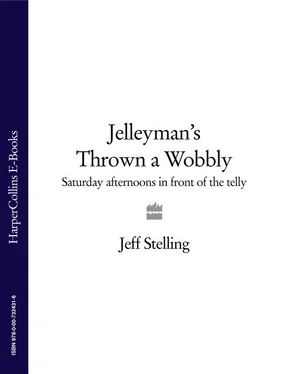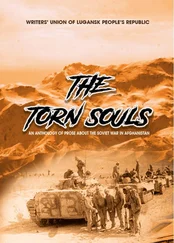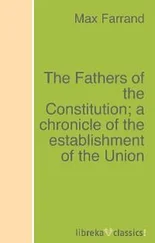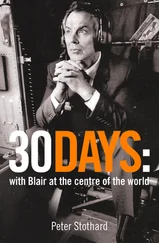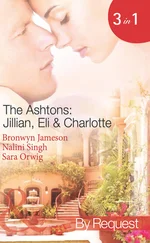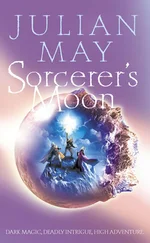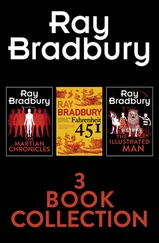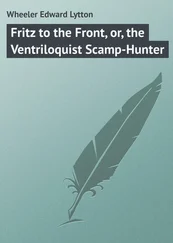Later, we ran a feature on the Junior Darts Challenge, which killed a bit of time. We covered the UK Strongman Challenge and the quest for Britain's Best Lady Driver, which was obviously a very short item. During the World Cup we had nothing in the way of live coverage because the TV rights had been cornered by ITV and the Beeb. Instead we laid out a cloth Subbuteo pitch on the studio table and for an hour and half – a full 90 minutes! – fellow easy-on-the-eye presenter Suzanne Dando and I flicked a little plastic ball around, recreating the live match on the other channel.
How anyone could have taken this concept seriously was beyond me. In fact, I remember during the early salvos of our ‘match’, I actually knelt down and crushed one of Suzanne Dando's players beyond repair. Somewhat embarrassingly, the producer went absolutely crazy off-camera. I later crushed another with my hand. It was a completely innocent accident, but I received a bollocking for not taking our little game seriously. But how could you? It was a bit like Fred Truman's 1970s show, Indoor League , a programme that focused on pub sports in a studio built to look like a pub. Sadly – or maybe brilliantly, however you wanted to look at it – Sports Saturday was much, much worse. I think if the programme existed now, it would probably have built a cult following.
I remember one Christmas - and I don't know how we got away with this, what with the rules and regulations that govern TV these days - we took a delivery from the Harrods warehouse, which was conveniently located next to the Sky studios. Very kindly, the store had couriered over a box of toys, all of which would be available from Harrods during the festive season at a very reasonable price, or so we were told. Given our desperate need to fill airtime, we decided to spend a couple of hours on Sports Saturday trying out every toy. We even invited former England cricketer Alan Lamb and current panellist Phil Thompson into the studio. Their kids were brought along to try out all the shiny gadgets and, presumably, add some much-needed maturity to the event.
‘Harrodsgate’ was blatant product placement and probably the lowest point of my broadcasting career, particularly when a Velcro hat appeared from one of the boxes. By all accounts it was one of the must-have toys of the year. It worked on the frankly absurd principle of hurling fuzzy balls onto targets marked on the hat. If a ball stuck, the triumphant thrower would score points. It seemed a stupid concept, but in a moment of TV gold, I donned the hat as former cricket legend and upstanding member of his local community Alan Lamb and various members of the studio crew threw balls at my head. It wasn't a particularly glorious image.
Elsewhere, everything was done on the cheap. Different guests would come in to lend their expertise to different sporting events. We used to drag jockeys into the studio for interviews, even though Sky had no horse racing coverage to speak of. Ex-football managers like Brian Horton would show up for two 20-minute windows (before the kick-off and after the final whistle) and stay for the duration of the show. I don't know what sort of fees were on offer, but it couldn't have been enough.
Outside broadcasts would take a particularly surreal turn. Alan Lamb and I were once invited to St Moritz in Switzerland where a yearly horse-racing-on-ice event is held by the locals (believe me, I wish I were making this up). Naturally, we weren't going to pass up a free trip to the Swiss Alps, especially when we discovered there was a local cricket team who were planning on playing cricket-on-ice, too. It was hardly the Winter Olympics, but it promised to be a bit of a giggle.
It wasn't until we got to the train that our usually organized party became embroiled in some minor chaos. It was the bloody slow train from Zurich up into the mountains. Everybody got bored and started to drink. Then we did what any right-thinking, slightly tipsy sports nut would do: we started a cricket match in the corridor of the train carriage. Typically, as with all things Sports Saturday , we didn't have a bat, stumps or ball, so we made do with bags, a brolly and tomatoes. After four overs, the train was splattered in red and resembled a scene from The Texas Chainsaw Massacre . Only a Velcro hat could have lowered the tone.
It came as no surprise when the Swiss train officials took a dim view of our behaviour. We were informed by a particularly disgruntled guard that the police would be waiting for us on our arrival in St Moritz. I remember thinking, ‘This will not look good.’ By the time we'd arrived everyone had been on their knees cleaning the train. It was spotless and the police were not required, so we'd got off scot-free, which was a relief. Better still, this marked the beginnings of Soccer Saturday as we now know it.
1997-98 BC (Before Chris Kamara)
I suppose, after the silly clothes, absurd reports and drunken misdemeanours, it was unsurprising that the show would change. And when some bright spark - I can't remember who exactly, it's been lost in the annals of time - had the idea of plonking four slightly overweight, ex-professional footballers in front of four tellies to report on matches the paying public couldn't see, we seemed to strike gold. It happened in one season, in 1998, and with the show's name changed to Soccer Saturday , we were suddenly working on a more football-based programme, which was a blessing because it would mean no more Velcro hats - or tomato-splattered train carriages. Even better, it seemed to capture the public's imagination, though nobody - not even me -really believed the concept had staying power. Who would want to watch four blokes watching football on the telly in a studio? Nevertheless, I began my role as anchorman on the nation's surrealist football magazine show.
Almost immediately it appeared to be good fun. In those days, Soccer Saturday started at two o'clock in the afternoon. We'd have an hour-long discussion with a panel, including Clive Allen and Mark Lawrenson, George Best, Rodney Marsh and Frank McLintock. It was principally the same idea as the show's current format, but at three o'clock we might move from football for a brief while to look at the horse racing or rugby. As more and more people began to discover that this was the only place to receive a comprehensive round-up of the day's football events, as and when they happened, the viewing figures began to increase.
Soccer Saturday began to develop into a word-of-mouth success – Sky never really promoted the show and some of our popularity came from the comedy of the afternoon. One idea at this point was for the panel to magically disappear from the studio desk at three o'clock. Each panellist would then sit in a little voice booth in another corner of the building to present telephone reports from their respective games. Why they couldn't stay on the panel and deliver their reports from there was beyond me. And why any right-thinking individual would believe that Frank McLintock had travelled from Middlesex to St James' Park to report on his game in the space of 10 minutes would require a massive leap of imagination.
This surreal situation was given an even stranger twist when our pundits piped their reports into the studio. As I introduced a new match, a picture of Rodney Marsh's face, say, would appear on the telly with his name underneath as he recalled the action at Highbury. Despite their close proximity, the phone lines would sometimes go down and we would lose contact, meaning the studio would be thrown into chaos. It was even less technologically-advanced than ‘Andy Townsend's Tactics Truck’ on ITV, and slightly more embarrassing. But only slightly.
Читать дальше
